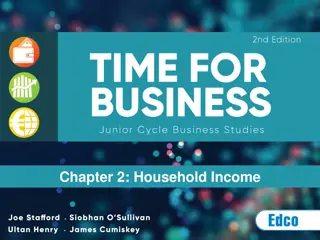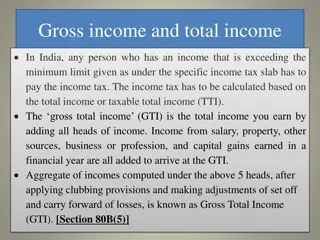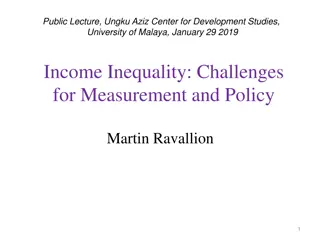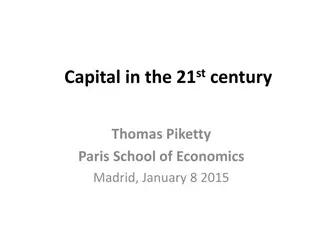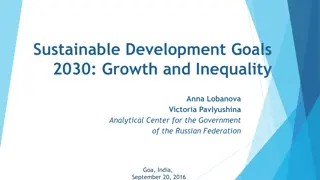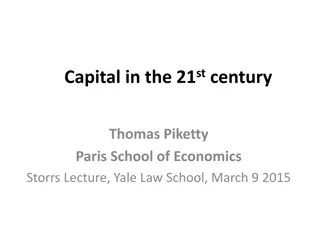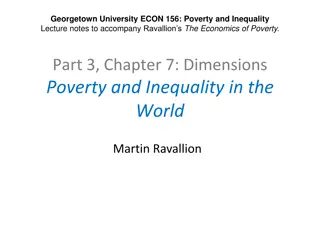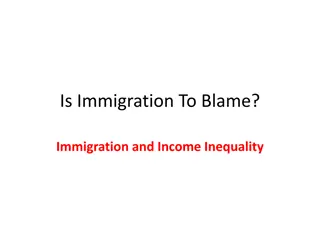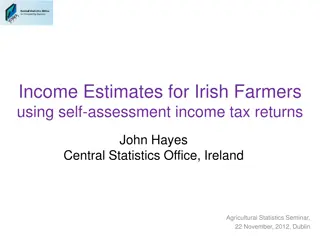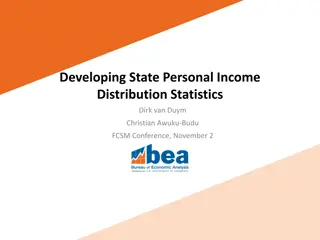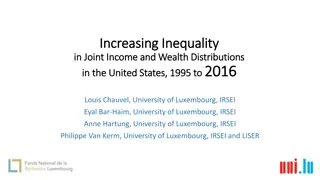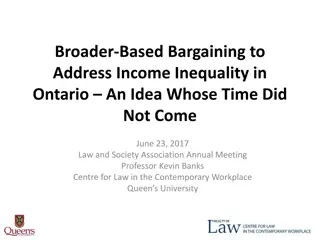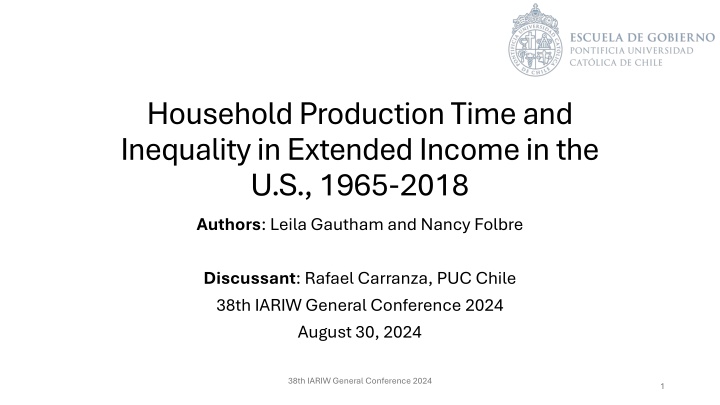
Household Production Time and Inequality in Extended Income
Study explores the impact of household production time on income inequality in the U.S. from 1965 to 2018. Main findings suggest a shift in unpaid work dynamics over time, affecting income distribution.
Download Presentation

Please find below an Image/Link to download the presentation.
The content on the website is provided AS IS for your information and personal use only. It may not be sold, licensed, or shared on other websites without obtaining consent from the author. If you encounter any issues during the download, it is possible that the publisher has removed the file from their server.
You are allowed to download the files provided on this website for personal or commercial use, subject to the condition that they are used lawfully. All files are the property of their respective owners.
The content on the website is provided AS IS for your information and personal use only. It may not be sold, licensed, or shared on other websites without obtaining consent from the author.
E N D
Presentation Transcript
HouseholdProductionTime and Inequalityin Extended Incomein the U.S., 1965-2018 Authors: Leila Gautham and Nancy Folbre Discussant: Rafael Carranza, PUC Chile 38th IARIW General Conference 2024 August 30, 2024 38th IARIW General Conference 2024 1
Summary Study of extended income inequality, the sum of: Household market income. Household production time (valued at MW). US data (1965-2018): CPS Annual Social and Economic Supplement American Heritage Time Use Study Reports time use, average incomes and inequality measures 38th IARIW General Conference 2024 2
Mainfindings Value of household production has an equalising effect. Household production has a (relatively) uniform distribution Gini in 2018: 0.44 0.38. Particularly relevant at the bottom of the distribution. Around half of all extended income at first decile. This effect has decreased over time. Mostly due to a reduction in hours of unpaid work by women. Partly due to MW becoming relatively less important ( Min/Avg) 38th IARIW General Conference 2024 3
Household production is the sum of housework and active care of children Housework: cooking, cleaning, purchasing goods, home repairs, etc. Active childcare: general/medical care, help with homework, reading, etc. Other sources: Supervisory childcare is added in a separate exercise. Excludes care of household adults 65+ population expected to go from 17% in 2020 to 23% in 2060 80+ population will triple in that time. 38th IARIW General Conference 2024 4
Imputinghouseholdproductiontime Regression-based approach on AHTUS Covariates: age, education, marital status, own employment and work hours, and spousal employment, and race. Separately by gender. Hours are predicted on the PSID. Small discrepancias withobserved values. Discrepancias uncorrelated with income. Robustness? 38th IARIW General Conference 2024 5
Total hoursofunpaidworkhavegonedown Housework has seen the largest change Decrease for women: 37 24 Slight increase for men: 12 15 Active childcare ~ constant: Lower fertility: Time per child. 38th IARIW General Conference 2024 6
Inequalityovertime Extended income inequality rose faster market income inequality. Extended income inequality is catching up to market inequality. 38th IARIW General Conference 2024 7
Household production is now less of a buffer tan before (Table B.5) Gini index Gini index 1965 1965 2018 2018 Difference Difference Market income 0.36 0.44 0.08 Extended income 0.27 0.38 0.11 Difference Difference 0.09 0.06 38th IARIW General Conference 2024 8
Mycomments 1. How to define income: Why market income? What s the role of transfers, taxes, pensions? 2. How to value and allocate household production: Including heterogeneity in valuation. 3. Findings: Using the Gini Thinking of household production as a transfer . 4. Ideas for future work: Policy implications 38th IARIW General Conference 2024 9
1. Whymarketincome? Motivation is to provide a picture of inequality in consumption and living standards . Then we should be looking at disposable income. Taxes and transfers play a role. The same applies for in-kind benefits (more on this at the end). 38th IARIW General Conference 2024 10
2. Howtovaluehouseholdproduction? Replacement cost set at state minimum wage MW goes from $7.25 (Federal rate) to $17.5 (DC) per hour. Full time wage: $15,080 to $36,400. Allocation assumes away differences across individuals: lower bounds. Robustness: Wage for maids and housekeepers 38th IARIW General Conference 2024 11 Source: en.wikipedia.org/wiki/List_of_US_states_by_minimum_wage
Maidsand housekeepersare thelowestpaid ofallcare workers Source: https://www.dol.gov/sites/dolgov/files/WB/DomesticWorkersFactSheet.pdf 38th IARIW General Conference 2024 12
High heterogeneityin wages Source: Burnham and Theodore (2012) HomeEconomics The Invisible and Unregulated World of Domestic Work 38th IARIW General Conference 2024 13
3. Findings Results are presented as ratios P90/P50 and P50/P10 are hard to see in Figures. Focus on changes in Gini (across income concepts) Easy to compare (e.g., US reduces 10.8 points via taxes and transfers). Can be decomposed into average rate, progressivity, and reranking. ? ???? = ? + ? 1 + ? (Kakwani, 1984; Herault and Jenkins, 2022) 38th IARIW General Conference 2024 14
4. Future work? Role ofsocial policy What s more important? Social protection spending or household production? Cross-country comparisons. Household production as a buffer. Potential examples: Redistribution via cash transfers or in-kind benefits Unemployment insurance vs. informal work. Distributional National Accounts 38th IARIW General Conference 2024
High cross-country heterogeneity US: 14.7% Source: ILO (2018) Care Work and Care Jobs for the Future of Decent Work 16
Whathappenedduringthepandemic? Source: Bridgmanet al. (2022) Accounting for Household Production in the National Accounts. SCB. 38th IARIW General Conference 2024 17
In conclusion Relevant work about an increasingly important topic. Lower bound estimates are useful but we should go beyond it. Heterogeneity across types of work, individual characteristics, etc. Including thecare of adults. Policy implications: Exploring the relationship betweenhousehold production and social protection. 38th IARIW General Conference 2024 18
HouseholdProductionTime and Inequalityin Extended Incomein the U.S., 1965-2018 Authors: Leila Gautham and Nancy Folbre Discussant: Rafael Carranza, PUC Chile 38th IARIW General Conference 2024 August 30, 2024 38th IARIW General Conference 2024 19
Howtoallocatethevalueofhousehold production? Regression-based imputations Large set of covariates (~30) and some cases with small N (e.g., 1995) Verification based on observed values. Within-survey comparison. Not possible for supervisory childcare (data for only a few years) What about out-of-sample predictions? e.g., random forests Brunori, P., Hufe, P. and Mahler, D. (2023), The roots of inequality: estimating inequality of opportunity from regression trees and forests. Scand. J. of Economics, 125: 900-932. 38th IARIW General Conference 2024 20
Averagevalueof householdproduction Market income has increased by 70%. Value of household production fell by 20%. Mostly due to fall in hours. Net: Extended income increased by 44% 38th IARIW General Conference 2024 21
Choiceofequivalencescales? One adult Three adults 4.0 4.0 3.5 3.5 3.0 3.0 2.5 2.5 2.0 2.0 1.5 1.5 1.0 1.0 0.5 0.5 0.0 0.0 0 1 2 3 4 5 0 1 2 3 4 5 Market income HH production OECD scale Market income HH production OECD scale (A+K)1/2 (A+2K)1/2 (A+K)1/2 (A+2K)1/2 38th IARIW General Conference 2024 22


